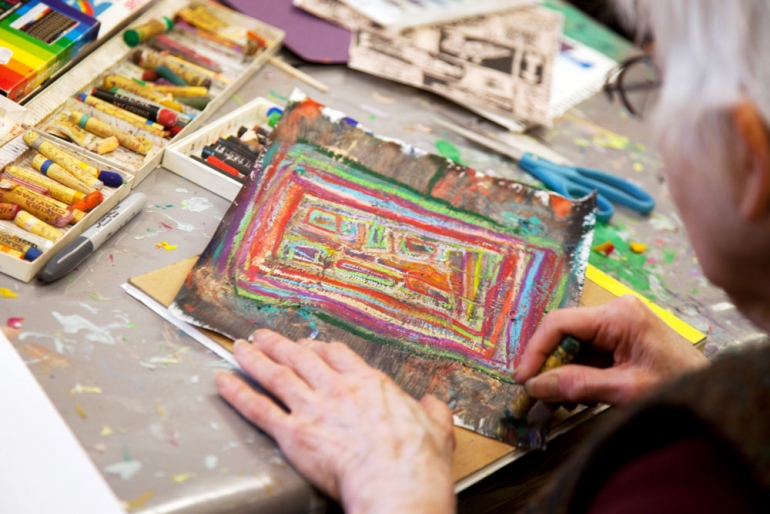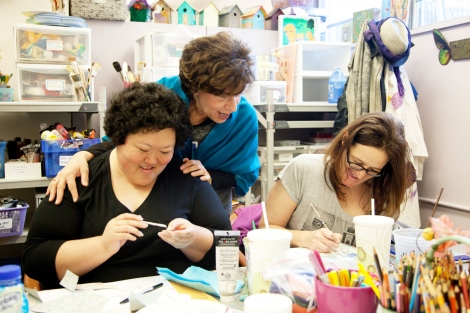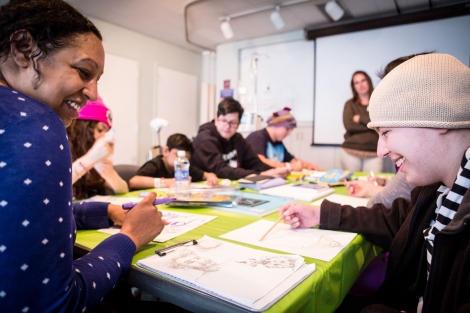How Has the Art of Health and Healing Been Affected by the Ever Changing Field of Science?

The idea of art every bit medicine dates back to antiquity, just recently the concept is drawing increasing interest from the medical and scientific discipline communities.
Seated at a table dotted with paintbrushes, pencils and curios, Hideka Suzuki is creating an abstruse on a small canvas. It's not an idle craft project; for her, information technology's a form of therapy.
"Sometimes I don't even know what I'm thinking until I sit down down and start cartoon. And so my feelings come out on paper," said Suzuki, a teacher in remission from uterine cancer.
She's a participant at Art for Recovery, a pioneering program at the UCSF Helen Diller Family unit Comprehensive Cancer Center that has brought patients together since 1988 under the philosophy that creating fine art – no skills required – has a key office in healing.
It'south hard to empirically measure that impact because so many of fine art's benefits are indirect, said Theresa Allison, MD, PhD, an associate professor in the UCSF Division of Geriatrics who has a groundwork in musical anthropology. Only, she said, therapies that benefit a patient's emotional wellbeing can take real bear upon on overall health.

Art for Recovery managing director Cindy Perlis, center, works with Hideka Suzuki, left, and Sylvia Parisotta, correct, equally they become creative during a program gathering at UCSF'due south Mount Zion campus on November. 12. Photo past Cindy Chew
"We are finally at a tipping point, where the health sciences recognize the affect of loneliness and low on wellness intendance outcomes, and we recognize the positive impact of visual and performing arts on symptoms management," Allison said.
"Now we're starting to ask why, and to bring in the science to report fine art'southward touch on. National funding agencies are starting to support this, and nosotros're going to see a lot of enquiry emerge in upcoming years."
Over the terminal few decades, a growing trunk of studies and anecdotal prove suggesting that art is healing have driven the incorporation of art into medical settings. Nearly half of the wellness care institutions in the United States reported including arts in health care programming, ranging from art and music therapy to featuring visual art in hospitals.
"It'south a huge opportunity to think about using different modes of healing," said Julene Johnson, PhD, a cognitive neuroscientist and professor at the UCSF Found for Health & Aging. She's running a report measuring the health impacts of singing in a choir. "The dainty thing about the arts is our long, long history of using music and arts for healing across thousands of years, and the fact that it's relatively depression toll to implement."
A History of Healing Influence
A landmark 1984 report published in Scientific discipline establish that patients recovering from gall float surgery recovered more than quickly if they were in infirmary rooms with a view of copse, as compared to a view of only a brick wall.
The patients were in the aforementioned suburban hospital with the aforementioned nurses in rooms that were close to identical, but those who could view nature required less strong painkillers and had shorter postoperative stays.

Fine art and Science Intertwined at UCSF
In 1999, equally the Mission Bay campus took its outset steps from vision to reality, then-Chancellor Mike Bishop pledged i per centum of campus structure costs to found initial funding for a public art plan. The chancellor'southward pledge followed UCSF'due south longstanding commitment to enrich campus life by integrating a wide range of art into public space, reflecting the diversity of the community.
Art at Mission Bay »
Fine art at UCSF Medical Center »
This fix the stage for a flurry of other research on design variables in health intendance settings that posed the aforementioned question: Could healing exist about more good medicine and empathetic clinicians? Not every hospital room can offer patients a bucolic view, so researchers sought to find out if art depicting a pleasing scene might deliver the same positive effects.
Indeed, multiple studies take shown that a hospital's physical environment is much more than than a properties for wellness care delivery. The presence of nature scenes and art has a measurable bear upon on patients' hurting levels.
For example, for about 75 percent of burn victims, painkillers fail to alleviate their pain. In a minor 1992 study in the Journal of Fire Care and Enquiry, researchers experimented with using videos of "scenic beauty" every bit a lark technique. Patients with severe burns reported lower pain intensity during dressing changes when shown the beautiful videos in addition to their medication.
Also, a 2003 written report out of Johns Hopkins University establish that nature scene murals displayed by the bedside reduced pain for patients undergoing bronchoscopy, a procedure in which a narrow tube with a telescopic is passed from the nose or mouth into the airways.
Hospitals across the land are increasingly acting on these findings.
At the UCSF Medical Centre at Mission Bay, art plays a key part in the design of the new cancer, women'due south and children's hospitals. In improver to art sculptures, paintings and interactive pieces featured throughout the complex, patient rooms include views of rooftop gardens or the San Francisco Bay, and browse rooms are equipped with screens displaying calming nature scenes.
"Nosotros wanted art to be integrated into the textile of our new facilities in a manner that reinforced the healing environment that nosotros were creating," said Cindy Lima, executive manager of UCSF Mission Bay Hospitals Projection.
Renowned Artists Contribute to Healing Surround
The new UCSF Medical Centre at Mission Bay, scheduled to open up on Feb. i, 2015, aims to provide a healing surround that features m fine art installations designed to inspire patients and the public alike. Watch the stories of how these beautiful works came together.
Reducing Stress and Channeling Emotions
In improver to viewing art or nature scenes, the act of creating fine art has been linked to improvement in emotional wellbeing.
A 2012 study published in Stress and Health of women with breast cancer found that a mindfulness-based art therapy program helped patients reduce stress and anxiety. The report looked at the encephalon using MRI, and constitute significant changes in the cerebral blood flow in regions corresponding to advantage and the regulation of stress response.
These positive neuropsychological changes were corroborated past the patients' reporting of reduced stress. The report's author noted that improved wellbeing is associated with improved immune function.
Suzanne Yau, an art therapist at UCSF Benioff Children'south Hospital San Francisco, believes that art is intrinsic to wellbeing for young patients as well.
"It provides opportunities for success and accomplishment, reduces feet, increases self-sensation and helps patients identify and explore their concerns," Yau said. "Perhaps most of import, information technology gives patients a voice when words are non accessible or simply non enough."
Art every bit Caring
To Cindy Perlis, director of the UCSF Art for Recovery plan, these findings are far from surprising.
She's watched thousands of patients – most of whom have stated that they have no artistic bent – create soulful self-portraits, make fiery masks and spirit houses, embellish quondam shoes with dazzling finery and blend words with paint strokes to brand striking visual statements. Equally a child, she turned to art to help her cope with the loss of her father.

Artist Shinique Smith, left, led a workshop with pediatric patients in May where they made art and wrote verse. She used their piece of work every bit inspiration for a sprawling wall mural at the new UCSF Medical Center at Mission Bay. Run into the finished production here. Photo past Elisabeth Fall
At the pinnacle of the AIDS furor in the 1980s, Perlis was recruited to start Art for Recovery. She recalls caring for patients who had wasting syndrome, pneumonia and Kaposi's sarcoma. Many were young men who had lost their partners and whose families had abandoned them.
"I was told to wear a gown, gloves and mask. I would sit on their bed and enquire them to limited their anger, fears, hopes and dreams. They'd put downwards on paper all the emotions that they couldn't articulate. And I'd concord their hand, because no i was touching them."
Interested in Fine art Therapy at UCSF?
The UCSF Helen Diller Comprehensive Cancer Center'southward Art for Recovery programme is currently located at the Mount Zion campus, and volition expand to UCSF Medical Center at Mission Bay after its opening on Feb. 1, 2015.
Learn more than
At the UCSF Benioff Children'south Hospital San Francisco, the Child Life Services programme offers art therapy for pediatric patients. When it moves to Mission Bay in February, information technology will too include a digital art studio and artistic art studio.
Larn more
"The experience fabricated me realize that, as an artist, this is where I needed to be," she said. "I hadn't been able to accept care of my father when he died, considering I was then young, but this gave me a chance to share my own creativity and take care of other people." Fifty-fifty those patients whose futures were dour and brutally short had found "healing" when they found art, according to Perlis.
Today participants in Art for Recovery are mainly cancer patients, like Suzuki. At a recent weekly art session, she painted with her friend Sylvia Parisotto, who worked equally an art conservationist until symptoms of a brain tumor impacted her fine motor skills.
Both women agreed that the plan gives them free rein to express the maelstrom of emotions that they take wrestled with during diagnosis and treatment.
"The truth comes out when I'k painting," said Parisotto, who is currently encephalon tumor-free but not classified as being in remission. "Art is a vehicle to express my innermost thoughts and fears."
With creative expression, comes an easy esprit amid participants, men and women from diverse backgrounds united by complex medical regimens of scans, surgeries and chemo infusions.
"It can be difficult to connect with people who don't have cancer," said Parisotto. "They might be very guarded or they might dismiss our concerns with a 'You'll exist fine.'"
Healing the Whole Person
Many of the benefits patients find in art are intangible, but they are real.
"I think the beauty of the arts is that they are whole person engagements," Allison said. "When we are looking at a painting, singing in a choir, or going to the theater, nosotros're engaging not but our intellect merely our hearts, and in that moment of being transported past the creative experience, this is a whole person experience."
As fine art therapy gains traction in the medical earth, more studies are looking at how emotional benefits of fine art are translating to other wellness improvements.
"We're a long manner away from being able to prescribe music or art like we would a medication," said Allison.
The connection between art and healing in the trunk are "complicated relationships," she said. "But i day I call back what may notice ourselves doing is prescribing music the way we prescribe exercise or other behavioral intervention."
Accept a tour of the art installations at the new UCSF Medical Centre at Mission Bay, which will feature works by renowned artists Spencer Finch, Ranjani Shettar, Barry McGee, Shinique Smith and many others.
Related Links
- Healing Harmonies: Testing the Power of Music to Amend Senior Health
Source: https://www.ucsf.edu/news/2014/12/121776/art-healing
Post a Comment for "How Has the Art of Health and Healing Been Affected by the Ever Changing Field of Science?"